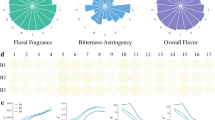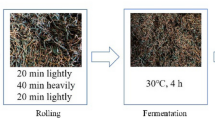Abstract
This study investigated the effect of brewing apparatus on the aromatic feature of tea infusion. Huangshan Maofeng tea infusion was brewed under glass tumblers (GT) or thermos vacuum mugs (TVM) for up to 180 min. Tea infusion sensory attributes were evaluated using quantitative descriptive analysis and the composition of volatiles were analyzed using headspace solid phase microextraction coupled with gas chromatography-mass spectrometry. Results showed that GT tea infusion at each brewing duration possessed stronger ‘Pure’, ‘Fresh’ and ‘Grassy’ attributes than TVM tea infusion, whereas TVM tea infusion showed a higher intensity on ‘Steamed’ aroma. A total of 74 volatiles were detected in tea infusion, and aldehydes and alcohols appeared to be the major volatiles. Total aldehydes concentration percentage decreased in tea infusion with brewing process, whereas an increase on total alcohol percentage was found. Principal component analysis indicated that brewing duration and apparatus played vital roles in altering the volatile composition in tea infusion, whereas orthogonal partial least squares discriminant analysis (OPLS-DA) revealed that GT tea infusion samples were separated from TVM tea infusion samples. OPLS-DA also screened 20 volatiles that significantly contributed to the differentiation of GT and TVM tea infusion.





Similar content being viewed by others
References
Ananingsih VK, Sharma A, Zhou W (2013) Green tea catechins during food processing and storage: a review on stability and detection. Food Res Int 50:469–479
Baba R, Kumazawa K (2014) Characterization of the potent odorants contributing to the characteristic aroma of Chinese green tea infusions by aroma extract dilution analysis. J Agric Food Chem 62:8308–8313
Bylesjö M, Rantalainen M, Cloarec O, Nicholson JK, Holmes E, Trygg J (2010) OPLS discriminant analysis: combining the strengths of PLS-DA and SIMCA classification. J Chemometr 20:341–351
Chacko SM, Thambi PT, Kuttan R, Nishigaki I (2010) Beneficial effects of green tea: A literature review. Chin Med. https://doi.org/10.1186/1749-8546-5-13
Chambers E, Koppel K (2013) Associations of volatile compounds with sensory aroma and flavor: the complex nature of flavor. Molecules 18:4887
Fang G, Goh JY, Tay M, Lau HF, Li SF (2013) Characterization of oils and fats by 1 H NMR and GC/MS fingerprinting: classification, prediction and detection of adulteration. Food Chem 138:1461–1469
Gong X et al (2017) Identification of the aroma-active compounds in Longjing tea characterized by odor activity value, gas chromatography- olfactometry, and aroma recombination. Int J Food Prop. https://doi.org/10.1080/10942912.2017.1336719
Guo GY, Hong-Zhou HE, Zhao WJ, Ming-Chao YU, Zhao-Hong LI (2010) Influence on organoleptic evaluation of Xinyang Maojian tea of brewing temperature, brewing time and ratio of tea and water. Food Sci Technol 35:120–123 (in Chinese)
Ho CT, Zheng X, Li S (2015) Tea aroma formation. Food Sci Hum Wellness 4:9–27
Huang J, Wang Y, Xie Z, Zhou Y, Zhang Y, Wan X (2014) The anti-obesity effects of green tea in human intervention and basic molecular studies. Eur J Clin Nutr 68:1075–1087
Jihee P, Jungmin L, Yongjin C, Chongtai K, Chuljin K, Kichang N, Seungcheol L (2009) Effect of far-infrared heater on the physicochemical characteristics of green tea during processing. J Food Biochem 33:149–162
Joshi R, Gulati A (2015) Fractionation and identification of minor and aroma-active constituents in Kangra orthodox black tea. Food Chem 167:290–298
Lee J, Chambers D, Chambers E (2013) Sensory and instrumental flavor changes in green tea brewed multiple times. Foods 2:554
Liu PP, Yin JF, Chen GS, Wang F, Xu YQ (2018) Flavor characteristics and chemical compositions of oolong tea processed using different semi-fermentation times. J Food Sci Tech 55:1185
Lucero M, Estell R, Tellez M, Fredrickson E (2010) A retention index calculator simplifies identification of plant volatile organic compounds. Phytochem Anal 20:378–384
Lv HP, Zhong QS, Lin Z, Wang L, Tan JF, Guo L (2012) Aroma characterisation of Pu-erh tea using headspace-solid phase microextraction combined with GC/MS and GC–olfactometry. Food Chem 130:1074–1081
Michele A et al (2007) Prevention of hypertension, cardiovascular damage and endothelial dysfunction with green tea extracts. Am J Hypertens 20:1321–1328
Owusu M, Petersen MA, Heimdal H (2013) Relationship of sensory and instrumental aroma measurements of dark chocolate as influenced by fermentation method, roasting and conching conditions. J Food Sci Tech 50:909–917
Qin Z, Pang X, Dong C, Cheng H, Hu X, Wu Lt J (2013) Evaluation of Chinese tea by the electronic nose and gas chromatography–mass spectrometry: correlation with sensory properties and classification according to grade level. Food Res Int 53:864–874
Ravichandran R (2002) Carotenoid composition, distribution and degradation to flavour volatiles during black tea manufacture and the effect of carotenoid supplementation on tea quality and aroma. Food Chem 78:23–28
Schuh C, Schieberle P (2006) Characterization of the key aroma compounds in the beverage prepared from Darjeeling black tea: quantitative differences between tea leaves and infusion. J Agric Food Chem 54:916–924
Setozaki S et al (2016) Prevention of abdominal aortic aneurysm progression by oral administration of green tea polyphenol in a rat model. J Vasc Surg 65:1803
Sheibani E, Duncan SE, Kuhn DD, Dietrich AM, O’Keefe SF (2016) SDE and SPME analysis of flavor compounds in Jin Xuan oolong tea. J Food Sci 81:C348
Shigeki Y, Kazuaki M, Akira M, Manabu M, Suong-Hyu H, Tadashi I, Ryuzo S (2011) Oral pretreatment with a green tea polyphenol for cardioprotection against ischemia-reperfusion injury in an isolated rat heart model. J Thorac Cardiov Surg 141:511–517
Stone H, Sidel J, Oliver S, Woolsey A, Singleton RC (2004) Sensory evaluation by quantitative descriptive analysis. Descr Sens Anal Pract 2004:23–34
Sun H, Chen Y, Cheng M, Zhang X, Zheng X, Zhang Z (2018) The modulatory effect of polyphenols from green tea, oolong tea and black tea on human intestinal microbiota in vitro. J Food Sci Tech 55:399–407
Wang LF, Jooyeon L, Jinoh C, Joohyun B, Sung S, Seungkook P (2008) Discrimination of teas with different degrees of fermentation by SPME-GC analysis of the characteristic volatile flavour compounds. Food Chem 109:196–206
Wang YC, Yuan HB, Jia LI, Dong CW, Hua JJ, Jiang YW (2017) Evaluation of taste of Yichang Congou black tea based on different brewing conditions. Sci Technol Food Ind 12:65–76 (in Chinese)
Xiao Z, Wang H, Niu Y, Liu Q, Zhu J, Chen H, Ma N (2017) Characterization of aroma compositions in different Chinese congou black teas using GC–MS and GC–O combined with partial least squares regression. Flavour Fragr J 32(4):265–276
Xu YQ, Zhang YN, Chen JX, Wang F, Du QZ, Yin JF (2018) Quantitative analyses of the bitterness and astringency of catechins from green tea. Food Chem 258:16–24
Yamamoto S, Bamba T, Sano A, Kodama Y, Imamura M, Obata A, Fukusaki E (2012) Metabolite profiling of soy sauce using gas chromatography with time-of-flight mass spectrometry and analysis of correlation with quantitative descriptive analysis. J Biosci Bioeng 114:170–175
Yang Z, Baldermann S, Watanabe N (2013) Recent studies of the volatile compounds in tea. Food Res Int 53:585–599
Zhu JC et al (2015) Comparison of aroma-active volatiles in oolong tea infusions using GC–olfactometry, GC–FPD, and GC–MS. J Agric Food Chem 63:7499–7510
Zhu Y et al (2018) Identification of key odorants responsible for chestnut-like aroma quality of green teas. Food Res Int 108:74–82
Acknowledgements
This study was finically supported by the National Key Research and Development Program (2017YFD0400805), National Nature Science Foundation of China (331772057) and National Modern Agriculture Technology System (CARS-19). We thanked Dr. Liwei Gu at the Food Science and Human Nutrition Department at the University of Florida for the assistance on principal component analysis and orthogonal projection on latent structure-discriminant analysis. Our sincere acknowledge also gave to Dr. Zheng Li in the Food Science and Human Nutrition Department at the University of Florida for his help on proofreading the manuscript.
Author information
Authors and Affiliations
Contributions
Q Dai, Z Zhang, D Li and Y Jiang conceived and designed the study. Q Dai and Y Jiang drafted the manuscript. Y Jiang, S Liu, J Gao performed the experiment. Y Jiang, S Liu, H Jin, H Wang, and M Xiao analyzed the data. All authors have read and approved the final manuscript.
Corresponding authors
Ethics declarations
Conflict of interest
All authors declared that they have no conflict of interests.
Additional information
Publisher's Note
Springer Nature remains neutral with regard to jurisdictional claims in published maps and institutional affiliations.
Rights and permissions
About this article
Cite this article
Dai, Q., Jiang, Y., Liu, S. et al. The impacts of brewing in glass tumblers and thermos vacuum mugs on the aromas of green tea (Camellia sinensis). J Food Sci Technol 56, 4632–4647 (2019). https://doi.org/10.1007/s13197-019-03911-6
Revised:
Accepted:
Published:
Issue Date:
DOI: https://doi.org/10.1007/s13197-019-03911-6




